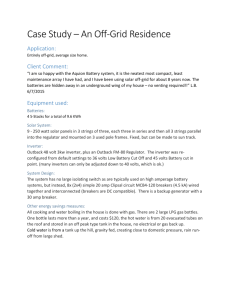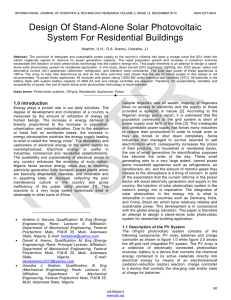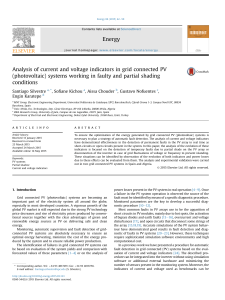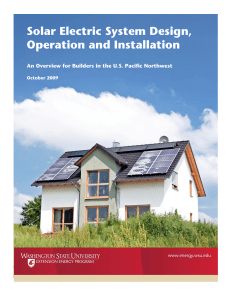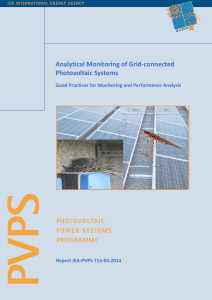Maintenance and Troubleshooting
advertisement
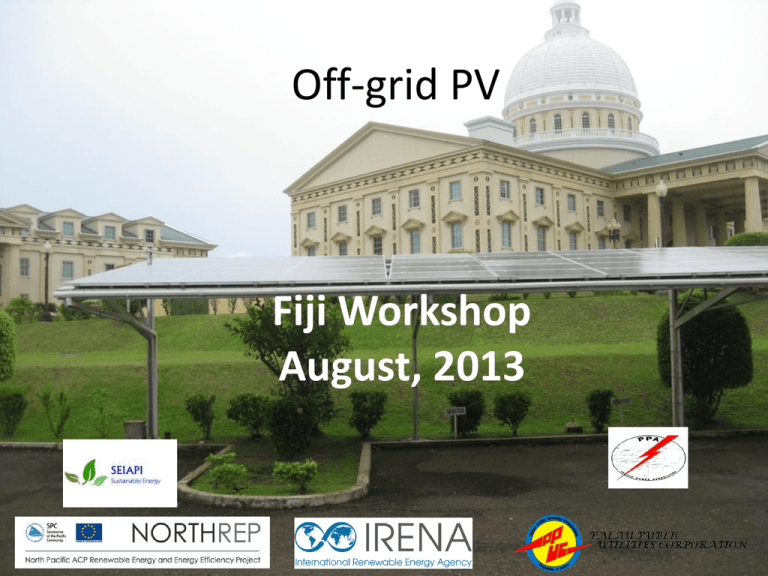
Off-grid PV Fiji Workshop August, 2013 Introduction • Maintenance: – We will cover basic requirements for each product. – Always follow manufacturers recommendations • Fault Finding: We will look at simple faults Maintenance Schedule and Log Books • Documentation supplied to the customer – booklet which contains maintenance log sheets for each of the equipment supplied Maintenance Solar Arrays and Modules • Clean modules (regularly as required) • Check array structure for loose mounting connections (when on site) • Check inter-module cables and other cables for mechanical damage (when on site) • Check total array output voltage and current and compare to what would be expected under the existing conditions. (when on site) Maintenance Solar Arrays and Modules: Log Book Date Cleaned Modules Checked Array Structure Checked Array Cabling Mechanical Checked Array Cabling Electrical Output Voltage Output Current Regulator Check Comments Fault Finding Solar Modules and Arrays 1. Modules are now shaded for some reason eg trees grown 2. Modules or parts of them are covered in dirt, bird dropping etc or are damaged 3. There is a loose connection in the wiring system or a hot joint has occurred and the cable has failed. Maintenance Regulators • Keep the unit clean and minimise dust. Clean when required • Ensure the unit is not “invaded” by insects and spiders. • Ensure all electrical connections are kept clean and tight Fault Finding Regulators • Many of today’s regulators microprocessor controlled – can require extensive programming on commissioning • Installer or maintainer of systems MUST be familiar with the regulator Maintenance Batteries (regularly) • Read & record the specific gravity (wet cell batteries) (Note some manufacturers require this monthly for warranty) • Check battery inter-cell connections and cable terminations for looseness and corrosion. Maintenance Batteries (regularly) • Check for damage of battery cases. • Check electrolyte level • Check and record cell voltage level Maintenance Batteries: Log Book DATE Battery Voltage Cell 1 S G Volts Temperature Cell 2 S G Volts Temperature Cell 3 S G Volts Temperature Cell 4 S G Volts Temperature …… Cell X S G Volts Temperature Interconnections OK? Battery Cases OK? Comments Maintenance Inverter • Keep the unit clean and minimise dust. Clean when required • Ensure the unit is not “invaded” by insects and spiders. • Ensure all electrical connections are kept clean and tight Fault Finding Inverter • Commonly used inverters microprocessor controlled • If the inverter is not providing an AC voltage it has failed. • Possible faults – Simple loose connection – Circuit breaker failure – Faulty power board or boards Maintaining System Integrity • For the individual components to work as a system they have been interconnected by both power cables and control cables. • Essential to undertake a visual check on the whole system to ensure no potential threat to the performance and/or safe operation of the system. Troubleshooting the Whole System • General complaint: – I don’t have any power! • Possible reasons: – Failure of any one (or more) particular item – Failure of the interconnection wiring between the system components – The customer using more power than the system was originally designed for Remember…. • Completing the installation and commissioning is only a small part • The real challenge starts after that: – Keeping the system going for the next 20+ years! End-user training Keep Batteries Clean! • • • • Batteries are expensive Terminal corrosion Short circuit Short life time Electrolyte checking and topping up Important! • Have Maintenance Schedule • Keep a Log Book • Keep the system Clean • High Maintenance Components: – Batteries – Generators – Pumps Troubleshouting • • • • Practical kits and Experience Knowledge of Components’ operation Understanding of the whole system Common sense, logic and intuition Failures 0% Inverter 63% Other faults 27% PV generato s 10% Monitoring & Datalogging
